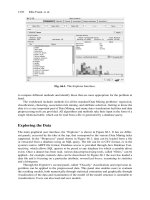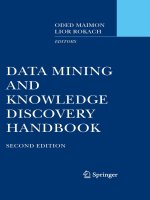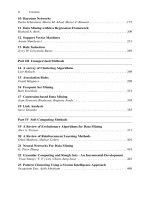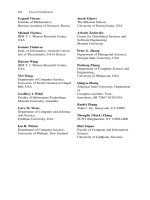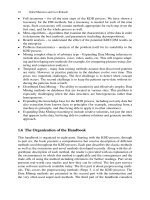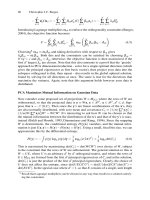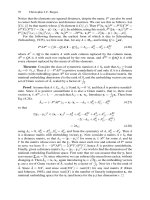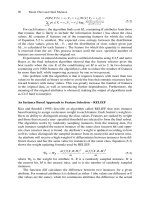Data Mining and Knowledge Discovery Handbook, 2 Edition part 15 doc
Bạn đang xem bản rút gọn của tài liệu. Xem và tải ngay bản đầy đủ của tài liệu tại đây (110.02 KB, 10 trang )
120 Irad Ben-Gal
Traditionally,
ˆ
μ
n
,
ˆ
σ
n
are estimated respectively by the sample mean, ¯x
n
, and the
sample standard deviation, S
n
. Since these estimates are highly affected by the pres-
ence of outliers, many procedures often replace them by other, more robust, estimates
that are discussed in Section 7.3.3. The multiple-comparison correction is used when
several statistical tests are being performed simultaneously. While a given
α
-value
may be appropriate to decide whether a single observation lies in the outlier region
(i.e., a single comparison), this is not the case for a set of several comparisons. In
order to avoid spurious positives, the
α
-value needs to be lowered to account for the
number of performed comparisons. The simplest and most conservative approach is
the Bonferroni’s correction, which sets the
α
-value for the entire set of n comparisons
equal to
α
, by taking the
α
-value for each comparison equal to
α
/n. Another popular
and simple correction uses
α
n
= 1−(1 −
α
)
1
/
n
. Note that the traditional Bonferroni’s
method is ”quasi-optimal” when the observations are independent, which is in most
cases unrealistic. The critical value g(n,
α
n
) is often specified by numerical proce-
dures, such as Monte Carlo simulations for different sample sizes (e.g., (Davies and
Gather, 1993)).
7.3.2 Inward and Outward Procedures
Sequential identifiers can be further classified to inward and outward procedures.
In inward testing, or forward selection methods, at each step of the procedure the
“most extreme observation”, i.e., the one with the largest outlyingness measure, is
tested for being an outlier. If it is declared as an outlier, it is deleted from the dataset
and the procedure is repeated. If it is declared as a non-outlying observation, the
procedure terminates. Some classical examples for inward procedures can be found
in (Hawkins, 1980,Barnett and Lewis, 1994).
In outward testing procedures, the sample of observations is first reduced to a
smaller sample (e.g., by a factor of two), while the removed observations are kept
in a reservoir. The statistics are calculated on the basis of the reduced sample and
then the removed observations in the reservoir are tested in reverse order to indicate
whether they are outliers. If an observation is declared as an outlier, it is deleted from
the reservoir. If an observation is declared as a non-outlying observation, it is deleted
from the reservoir, added to the reduced sample, the statistics are recalculated and
the procedure repeats itself with a new observation. The outward testing procedure
is terminated when no more observations are left in the reservoir. Some classical ex-
amples for inward procedures can be found in (Rosner, 1975,Hawkins, 1980,Barnett
and Lewis, 1994).
The classification to inward and outward procedures also applies to multivariate
outlier detection methods.
7.3.3 Univariate Robust Measures
Traditionally, the sample mean and the sample variance give good estimation for
data location and data shape if it is not contaminated by outliers. When the database
7 Outlier Detection 121
is contaminated, those parameters may deviate and significantly affect the outlier-
detection performance.
Hampel (1971, 1974) introduced the concept of the breakdown point, as a mea-
sure for the robustness of an estimator against outliers. The breakdown point is de-
fined as the smallest percentage of outliers that can cause an estimator to take arbi-
trary large values. Thus, the larger breakdown point an estimator has, the more robust
it is. For example, the sample mean has a breakdown point of 1/nsince a single large
observation can make the sample mean and variance cross any bound. Accordingly,
Hampel suggested the median and the median absolute deviation (MAD) as robust
estimates of the location and the spread. The Hampel identifier is often found to be
practically very effective (Perarson, 2002,Liu et al., 2004). Another earlier work that
addressed the problem of robust estimators was proposed by Tukey (1977) . Tukey
introduced the Boxplot as a graphical display on which outliers can be indicated. The
Boxplot, which is being extensively used up to date, is based on the distribution quad-
rants. The first and third quadrants, Q
1
and Q
3
, are used to obtain the robust measures
for the mean,
ˆ
μ
n
=(Q
1
+ Q
3
)
2, and the standard deviation,
ˆ
σ
n
= Q
3
−Q
1
. Another
popular solution to obtain robust measures is to replace the mean by the median and
compute the standard deviation based on (1–
α
) percents of the data points, where
typically
α
¡5%.
Liu et al. (2004) proposed an outlier-resistant data filter-cleaner based on the ear-
lier work of Martin and Thomson (1982) . The proposed data filter-cleaner includes
an on-line outlier-resistant estimate of the process model and combines it with a
modified Kalman filter to detect and “clean” outliers. The proposed method does not
require an apriori knowledge of the process model. It detects and replaces outliers
on-line while preserving all other information in the data. The authors demonstrated
that the proposed filter-cleaner is efficient in outlier detection and data cleaning for
autocorrelated and even non-stationary process data.
7.3.4 Statistical Process Control (SPC)
The field of Statistical Process Control (SPC) is closely-related to univariate outlier
detection methods. It considers the case where the univariable stream of measures
represents a stochastic process, and the detection of the outlier is required online.
SPC methods are being applied for more than half a century and were extensively
investigated in statistics literature.
Ben-Gal et al. (2003) categorize SPC methods by two major criteria: i) meth-
ods for independent data versus methods for dependent data; and ii) methods that
are model-specific, versus methods that are model-generic. Model specific methods
require a-priori assumptions on the process characteristics, usually defined by an un-
derlying analytical distribution or a closed-form expression. Model-generic methods
try to estimate the underlying model with minimum a-priori assumptions.
Traditional SPC methods, such as Shewhart, Cumulative Sum (CUSUM) and
Exponential Weighted Moving Average (EWMA) are model-specific for independent
data. Note that these methods are extensively implemented in industry, although the
independence assumptions are frequently violated in practice.
122 Irad Ben-Gal
The majority of model-specific methods for dependent data are based on time-
series. Often, the underlying principle of these methods is as follows: find a time
series model that can best capture the autocorrelation process, use this model to filter
the data, and then apply traditional SPC schemes to the stream of residuals. In par-
ticular, the ARIMA (Auto Regressive Integrated Moving Average) family of models
is widely implemented for the estimation and filtering of process autocorrelation.
Under certain assumptions, the residuals of the ARIMA model are independent and
approximately normally distributed, to which traditional SPC can be applied. Fur-
thermore, it is commonly conceived that ARIMA models, mostly the simple ones
such as AR(see Equation 7.1), can effectively describe a wide variety of industry
processes (Box, 1976, Apley and Shi, 1999).
Model-specific methods for dependent data can be further partitioned to parameter-
dependent
methods that require explicit estimation of the model parameters (e.g.,
(Alwan and Roberts, 1988, Wardell et al., 1994, Lu and Reynolds, 1999, Runger
and Willemain, 1995, Apley and Shi, 1999)), and to parameter-free methods, where
the model parameters are only implicitly derived, if at all (Montgomery and Mas-
trangelo, 1991, Zhang, 1998).
The Information Theoretic Process Control (ITPC) is an example for a model-
generic SPC method for independent data, proposed in (Alwan et al., 1998). Finally,
a model-generic SPC method for dependent data is proposed in (Gal et al., 2003).
7.4 Multivariate Outlier Detection
In many cases multivariable observations can not be detected as outliers when each
variable is considered independently. Outlier detection is possible only when mul-
tivariate analysis is performed, and the interactions among different variables are
compared within the class of data. A simple example can be seen in Figure 7.1,
which presents data points having two measures on a two-dimensional space. The
lower left observation is clearly a multivariate outlier but not a univariate one. When
considering each measure separately with respect to the spread of values along the x
and y axes, we can is seen that they fall close to the center of the univariate distribu-
tions. Thus, the test for outliers must take into account the relationships between the
two variables, which in this case appear abnormal.
Data sets with multiple outliers or clusters of outliers are subject to masking and
swamping effects. Although not mathematically rigorous, the following definitions
from (Acuna and Rodriguez, 2004) give an intuitive understanding for these effects
(for other definitions see (Hawkins, 1980, Iglewics and Martinez, 1982, Davies and
Gather, 1993, Barnett and Lewis, 1994)):
Masking effect It is said that one outlier masks a second outlier, if the second outlier
can be considered as an outlier only by itself, but not in the presence of the first
outlier. Thus, after the deletion of the first outlier the second instance is emerged
as an outlier. Masking occurs when a cluster of outlying observations skews the
mean and the covariance estimates toward it, and the resulting distance of the
outlying point from the mean is small.
7 Outlier Detection 123
x
y
Fig. 7.1. A Two-Dimensional Space with one Outlying Observation (Lower Left Corner).
Swamping effect It is said that one outlier swamps a second observation, if the latter
can be considered as an outlier only under the presence of the first one. In other
words, after the deletion of the first outlier the second observation becomes a
non-outlying observation. Swamping occurs when a group of outlying instances
skews the mean and the covariance estimates toward it and away from other non-
outlying instances, and the resulting distance from these instances to the mean is
large, making them look like outliers. A single step procedure with low masking
and swamping is given in (Iglewics and Martinez, 1982).
7.4.1 Statistical Methods for Multivariate Outlier Detection
Multivariate outlier detection procedures can be divided to statistical methods that
are based on estimated distribution parameters, and data-mining related methods that
are typically parameter-free.
Statistical methods for multivariate outlier detection often indicate those obser-
vations that are located relatively far from the center of the data distribution. Several
distance measures can be implemented for such a task. The Mahalanobis distance is
a well-known criterion which depends on estimated parameters of the multivariate
distribution. Given n observations from a p-dimensional dataset (oftenn¿¿ p), denote
the sample mean vector by
¯
x
n
and the sample covariance matrix by V
n
, where
V
n
=
1
n −1
n
∑
i=1
(x
i
−
¯
x
n
)(x
i
−
¯
x
n
)
T
(7.3)
The Mahalanobis distance for each multivariate data point i, i = 1, ,n, is de-
noted by M
i
and given by
124 Irad Ben-Gal
M
i
=
n
∑
i=1
(x
i
−
¯
x
n
)
T
V
−1
n
(x
i
−
¯
x
n
)
1
/
2
. (7.4)
Accordingly, those observations with a large Mahalanobis distance are indicated
as outliers. Note that masking and swamping effects play an important rule in the
adequacy of the Mahalanobis distance as a criterion for outlier detection. Namely,
masking effects might decrease the Mahalanobis distance of an outlier. This might
happen, for example, when a small cluster of outliers attracts
¯
x
n
and inflate V
n
to-
wards its direction. On the other hand, swamping effects might increase the Maha-
lanobis distance of non-outlying observations. For example, when a small cluster
of outliers attracts
¯
x
n
and inflate V
n
away from the pattern of the majority of the
observations (see (Penny and Jolliffe, 2001)).
7.4.2 Multivariate Robust Measures
As in one-dimensional procedures, the distribution mean (measuring the location)
and the variance-covariance (measuring the shape) are the two most commonly used
statistics for data analysis in the presence of outliers
(Rousseeuw and Leory, 1987). The use of robust estimates of the multidimensional
distribution parameters can often improve the performance of the detection proce-
dures in presence of outliers. Hadi (1992) addresses this problem and proposes to
replace the mean vector by a vector of variable medians and to compute the co-
variance matrix for the subset of those observations with the smallest Mahalanobis
distance. A modified version of Hadi’s procedure is presented in (Penny and Jol-
liffe, 2001). Caussinus and Roiz (1990) propose a robust estimate for the covariance
matrix, which is based on weighted observations according to their distance from
the center. The authors also propose a method for a low dimensional projections
of the dataset. They use the Generalized Principle Component Analysis (GPCA)
to reveal those dimensions which display outliers. Other robust estimators of the
location (centroid) and the shape (covariance matrix) include the minimum covari-
ance determinant (MCD) and the minimum volume ellipsoid (MVE) (Rousseeuw,
1985, Rousseeuw and Leory, 1987, Acuna and Rodriguez, 2004).
7.4.3 Data-Mining Methods for Outlier Detection
In contrast to the above-mentioned statistical methods, data-mining related methods
are often non-parametric, thus, do not assume an underlying generating model for the
data. These methods are designed to manage large databases from high-dimensional
spaces. We follow with a short discussion on three related classes in this category:
distance-based methods, clustering methods and spatial methods.
Distance-based methods were originally proposed by Knorr and Ng (1997, 1998)
. An observation is defined as a distance-based outlier if at least a fraction
β
of the
observations in the dataset are further than r from it. Such a definition is based on
a single, global criterion determined by the parameters r and
β
. As pointed out in
Acuna and Rodriguez (2004), such definition raises certain difficulties, such as the
7 Outlier Detection 125
determination of r and the lack of a ranking for the outliers. The time complexity of
the algorithm is O(pn
2
), where p is the number of features and n is the sample size.
Hence, it is not an adequate definition to use with very large datasets. Moreover,
this definition can lead to problems when the data set has both dense and sparse
regions (Breunig et al., 2000, Ramaswamy et al., 2000, Papadimitriou et al., 2002).
Alternatively, Ramaswamy et al. (2000) suggest the following definition: given two
integers v and l (v¡ l), outliers are defined to be the top l sorted observations having
the largest distance to their v-th nearest neighbor. One shortcoming of this definition
is that it only considers the distance to the v-th neighbor and ignores information
about closer observations. An alternative is to define outliers as those observations
having a large average distance to the v-th nearest neighbors. The drawback of this
alternative is that it takes longer to be calculated (Acuna and Rodriguez, 2004).
Clustering based methods consider a cluster of small sizes, including the size
of one observation, as clustered outliers. Some examples for such methods are the
partitioning around medoids (PAM) and the clustering large applications (CLARA)
(Kaufman and Rousseeuw, 1990); a modified version of the latter for spatial outliers
called CLARANS (Ng and Han, 1994); and a fractal-dimension based method (Bar-
bara and Chen, 2000). Note that since their main objective is clustering, these meth-
ods are not always optimized for outlier detection. In most cases, the outlier detection
criteria are implicit and cannot easily be inferred from the clustering procedures (Pa-
padimitriou et al., 2002).
Spatial methods are closely related to clustering methods. Lu et al. (2003) define
a spatial outlier as a spatially referenced object whose non-spatial attribute values are
significantly different from the values of its neighborhood. The authors indicate that
the methods of spatial statistics can be generally classified into two sub categories:
quantitative tests and graphic approaches. Quantitative methods provide tests to dis-
tinguish spatial outliers from the remainder of data. Two representative approaches
in this category are the Scatterplot (Haining, 1993,Luc, 1994) and the Moran scatter-
plot (Luc, 1995). Graphic methods are based on visualization of spatial data which
highlights spatial outliers. Variogram clouds and pocket plots are two examples for
these methods (Haslett et al., 1991, Panatier, 1996). Schiffman et al. (1981) suggest
using a multidimensional scaling (MDS) that represents the similarities between ob-
jects spatially, as in a map. MDS seeks to find the best configuration of the obser-
vations in a low dimensional space. Both metric and non-metric forms of MDS are
proposed in (Penny and Jolliffe, 2001). As indicated above, Ng and Han (1994) de-
velop a clustering method for spatial data-mining called CLARANS which is based
on randomized search. The authors suggest two spatial data-mining algorithms that
use CLARANS. Shekhar et al. (2001, 2002) introduce a method for detecting spatial
outliers in graph data set. The method is based on the distribution property of the
difference between an attribute value and the average attribute value of its neighbors.
Shekhar et al. (2003) propose a unified approach to evaluate spatial outlier-detection
methods. Lu et al. (2003) propose a suite of spatial outlier detection algorithms to
minimize false detection of spatial outliers when their neighborhood contains true
spatial outliers.
126 Irad Ben-Gal
Applications of spatial outliers can be found in fields where spatial information
plays an important role, such as, ecology, geographic information systems, trans-
portation, climatology, location-based services, public health and public safety (Ng
and Han, 1994, Shekhar and Chawla, 2002, Lu et al., 2003).
7.4.4 Preprocessing Procedures
Different paradigms were suggested to improve the efficiency of various data analy-
sis tasks including outlier detection. One possibility is to reduce the size of the data
set by assigning the variables to several representing groups. Another option is to
eliminate some variables from the analyses by methods of data reduction (Barbara
et al., 1996), such as methods of principal components and factor analysis that are
further discussed in Chapters 3.4 and 4.3 of this volume.
Another means to improve the accuracy and the computational tractability of
multiple outlier detection methods is the use of biased sampling. Kollios et al. (2003)
investigate the use of biased sampling according to the density of the data set to
speed up the operation of general data-mining tasks, such as clustering and outlier
detection.
7.5 Comparison of Outlier Detection Methods
Since different outlier detection algorithms are based on disjoints sets of assumption,
a direct comparison between them is not always possible. In many cases, the data
structure and the outlier generating mechanism on which the study is based dictate
which method will outperform the others. There are few works that compare different
classes of outlier detection methods.
Williams et al. (2002) , for example, suggest an outlier detection method based on
replicator neural networks (RNNs). They provide a comparative study of RNNs with
respect to two parametric (statistical) methods (one proposed in (Hadi, 1994), and the
other proposed in (Knorr et al., 2001)) and one data-mining non-parametric method
(proposed in (Oliver et al., 1996)). The authors find that RNNs perform adequately to
the other methods in many cases, and particularly well on large datasets. Moreover,
they find that some statistical outlier detection methods scale well for large dataset,
despite claims to the contrary in the data-mining literature. They summaries the study
by pointing out that in outlier detection problems simple performance criteria do not
easily apply.
Shekhar et al. (2003) characterize the computation structure of spatial outlier de-
tection methods and present scalable algorithms to which they also provide a cost
model. The authors present some experimental evaluations of their algorithms us-
ing a traffic dataset. Their experimental results show that the connectivity-clustered
access model (CCAM) achieves the highest clustering efficiency value with respect
to a predefined performance measure. Lu et al. (2003) compare three spatial out-
lier detection algorithms. Two algorithms are sequential and one algorithm based on
7 Outlier Detection 127
median as a robust measure for the mean. Their experimental results confirm the
effectiveness of these approaches in reducing the risk of falsely negative outliers.
Finally, Penny and Jolliffe (2001) conduct a comparison study with six multivari-
ate outlier detection methods. The methods’ properties are investigated by means of
a simulation study and the results indicate that no technique is superior to all oth-
ers. The authors indicate several factors that affect the efficiency of the analyzed
methods. In particular, the methods depend on: whether or not the data set is multi-
variate normal; the dimension of the data set; the type of the outliers; the proportion
of outliers in the dataset; and the outliers’ degree of contamination (outlyingness).
The study motivated the authors to recommend the use of a ”battery of multivariate
methods” on the dataset in order to detect possible outliers. We fully adopt such a
recommendation and argue that the battery of methods should depend, besides on
the above-mentioned factors, but also on other factors such as, the data structure di-
mension and size; the time constraints in regard to single vs. sequential identifiers;
and whether an online or an offline outlier detection is required.
References
Acuna E., Rodriguez C. A., ”Meta analysis study of outlier detection methods in classi-
fication,” Technical paper, Department of Mathematics, University of Puerto Rico at
Mayaguez, Retrived from academic.uprm.edu/ eacuna/paperout.pdf. In proceedings IPSI
2004, Venice, 2004.
Alwan L.C., Ebrahimi N., Soofi E.S., ”Information theoretic framework for process control,”
European Journal of Operations Research, 111, 526-542, 1998.
Alwan L.C., Roberts H.V., ”Time-series modeling for statistical process control,” Journal of
Business and Economics Statistics, 6 (1), 87-95, 1988.
Apley D.W., Shi J., ”The GLRT for statistical process control of autocorrelated processes,”
IIE Transactions, 31, 1123-1134, 1999.
Barbara D., Faloutsos C., Hellerstein J., Ioannidis Y., Jagadish H.V., Johnson T., Ng R.,
Poosala V., Ross K., Sevcik K.C., ”The New Jersey Data Reduction Report,” Data Eng.
Bull., September, 1996.
Barbara D., Chen P., ”Using the fractal dimension to cluster datasets,” In Proc. ACM KDD
2000, 260-264, 2000.
Barnett V., Lewis T., Outliers in Statistical Data. John Wiley, 1994.
Bay S.D., Schwabacher M., ”Mining distance-based outliers in near linear time with ran-
domization and a simple pruning rule,” In Proc. of the ninth ACM-SIGKDD Conference
on Knowledge Discovery and Data Mining, Washington, DC, USA, 2003.
Ben-Gal I., Morag G., Shmilovici A., ”CSPC: A Monitoring Procedure for State Dependent
Processes,” Technometrics, 45(4), 293-311, 2003.
Box G. E. P., Jenkins G. M., Times Series Analysis, Forecasting and Control, Oakland, CA:
Holden Day, 1976.
Breunig M.M., Kriegel H.P., Ng R.T., Sander J., ”Lof: Identifying density-based local out-
liers,” In Proc. ACMSIGMOD Conf. 2000, 93–104, 2000.
Caussinus H., Roiz A., ”Interesting projections of multidimensional data by means of gener-
alized component analysis,” In Compstat 90, 121-126, Heidelberg: Physica, 1990.
David H. A., ”Robust estimation in the presence of outliers,” In Robustness in Statistics, eds.
R. L. Launer and G.N. Wilkinson, Academic Press, New York, 61-74, 1979.
128 Irad Ben-Gal
Davies L., Gather U., ”The identification of multiple outliers,” Journal of the American Sta-
tistical Association, 88(423), 782-792, 1993.
DuMouchel W., Schonlau M., ”A fast computer intrusion detection algorithm based on hy-
pothesis testing of command transition probabilities,” In Proceedings of the 4th Interna-
tional Conference on Knowledge Discovery and Data-mining (KDD98), 189–193, 1998.
Fawcett T., Provost F., ”Adaptive fraud detection,” Data-mining andKnowledge Discovery,
1(3), 291–316, 1997.
Ferguson T. S., ”On the Rejection of outliers,” In Proceedings of the Fourth Berkeley Sym-
posium on Mathematical Statistics and Probability, vol. 1, 253-287, 1961.
Gather U., ”Testing for multisource contamination in location / scale families,” Communica-
tion in Statistics, Part A: Theory and Methods, 18, 1-34, 1989.
Grubbs F. E., ”Proceadures for detecting outlying observations in Samples,” Technometrics,
11, 1-21, 1969.
Hadi A. S., ”Identifying multiple outliers in multivariate data,” Journal of the Royal Statisti-
cal Society. Series B, 54, 761-771, 1992.
Hadi A. S., ”A modification of a method for the detection of outliers in multivariate samples,”
Journal of the Royal Statistical Society, Series B, 56(2), 1994.
Hawkins D., Identification of Outliers, Chapman and Hall, 1980.
Hawkins S., He H. X., Williams G. J., Baxter R. A., ”Outlier detection using replicator neural
networks,” In Proceedings of the Fifth International Conference and Data Warehousing
and Knowledge Discovery (DaWaK02), Aix en Provence, France, 2002.
Haining R., Spatial Data Analysis in the Social and Environmental Sciences. Cambridge
University Press, 1993.
Hampel F. R., ”A general qualitative definition of robustness,” Annals of Mathematics Statis-
tics, 42, 1887–1896, 1971.
Hampel F. R., ”The influence curve and its role in robust estimation,” Journal of the American
Statistical Association, 69, 382–393, 1974.
Haslett J., Brandley R., Craig P., Unwin A., Wills G., ”Dynamic Graphics for Exploring
Spatial Data With Application to Locating Global and Local Anomalies,” The American
Statistician, 45, 234–242, 1991.
Hu T., Sung S. Y., Detecting pattern-based outliers, Pattern Recognition Letters, 24, 3059-
3068.
Iglewics B., Martinez J., Outlier Detection using robust measures of scale, Journal of Sattis-
tical Computation and Simulation, 15, 285-293, 1982.
Jin W., Tung A., Han J., ”Mining top-n local outliers in large databases,” In Proceedings of
the 7th International Conference on Knowledge Discovery and Data-mining (KDD01),
San Francisco, CA, 2001.
Johnson R., Applied Multivariate Statistical Analysis. Prentice Hall, 1992.
Johnson T., Kwok I., Ng R., ”Fast Computation of 2-Dimensional Depth Contours,” In Pro-
ceedings of the Fourth International Conference on Knowledge Discovery and Data Min-
ing, 224-228. AAAI Press, 1998.
Kaufman L., Rousseeuw P.J., Finding Groups in Data: An Introduction to Cluster Analysis.
Wiley, New York, 1990.
Knorr E., Ng R., ”A unified approach for mining outliers,” In Proceedings Knowledge Dis-
covery KDD, 219-222, 1997.
Knorr E., Ng. R., ”Algorithms for mining distance-based outliers in large
datasets,” In Proc. 24th Int. Conf. Very Large Data Bases (VLDB), 392-403, 24-
27, 1998.
7 Outlier Detection 129
Knorr, E., Ng R., Tucakov V., ”Distance-based outliers: Algorithms and applications,” VLDB
Journal: Very Large Data Bases, 8(3-4):237-253, 2000.
Knorr E. M., Ng R. T., Zamar R. H., ”Robust space transformations for distance based op-
erations,” In Proceedings of the 7th International Conference on Knowledge Discovery
and Data-mining (KDD01), 126-135, San Francisco, CA, 2001.
Kollios G., Gunopulos D., Koudas N., Berchtold S., ”Efficient biased sampling for approx-
imate clustering and outlier detection in large data sets,” IEEE Transactions on Knowl-
edge and Data Engineering, 15 (5), 1170-1187, 2003.
Liu H., Shah S., Jiang W., ”On-line outlier detection and data cleaning,” Computers and
Chemical Engineering, 28, 1635–1647, 2004.
Lu C., Chen D., Kou Y., ”Algorithms for spatial outlier detection,” In Proceedings of the 3rd
IEEE International Conference on Data-mining (ICDM’03), Melbourne, FL, 2003.
Lu C.W., Reynolds M.R., ”EWMA Control Charts for Monitoring the Mean of Autocorre-
lated Processes,” Journal of Quality Technology, 31 (2), 166-188, 1999.
Luc A., ”Local Indicators of Spatial Association: LISA,” Geographical Analysis, 27(2), 93-
115, 1995.
Luc A., ”Exploratory Spatial Data Analysis and Geographic Information Systems,” In M.
Painho, editor, New Tools for Spatial Analysis, 45-54, 1994.
Martin R. D., Thomson D. J., ”Robust-resistant spectrum estimation,” In Proceeding of the
IEEE, 70, 1097-1115, 1982.
Montgomery D.C., Mastrangelo C.M., ”Some statistical process control methods for auto-
correlated data,” Journal of Quality Technology, 23 (3), 179-193, 1991.
Ng R.T., Han J., Efficient and Effective Clustering Methods for Spatial Data Mining, In
Proceedings of Very Large Data Bases Conference, 144-155, 1994.
Oliver J. J., Baxter R. A., Wallace C. S., ”Unsupervised Learning using MML,” In Pro-
ceedings of the Thirteenth International Conference (ICML96), pages 364-372, Morgan
Kaufmann Publishers, San Francisco, CA, 1996.
Panatier Y., Variowin. Software for Spatial Data Analysis in 2D., Springer-Verlag, New York,
1996.
Papadimitriou S., Kitawaga H., Gibbons P.G., Faloutsos C., ”LOCI: Fast Outlier Detection
Using the Local Correlation Integral,” Intel research Laboratory Technical report no.
IRP-TR-02-09, 2002.
Penny K. I., Jolliffe I. T., ”A comparison of multivariate outlier detection methods for clinical
laboratory safety data,” The Statistician 50(3), 295-308, 2001.
Perarson R. K., ”Outliers in process modeling and identification,” IEEE Transactions on
Control Systems Technology, 10, 55-63, 2002.
Ramaswamy S., Rastogi R., Shim K., ”Efficient algorithms for mining outliers from large
data sets,” In Proceedings of the ACM SIGMOD International Conference on Manage-
ment of Data, Dalas, TX, 2000.
Rokach, L., Averbuch, M., and Maimon, O., Information retrieval system for medical narra-
tive reports. Lecture notes in artificial intelligence, 3055. pp. 217-228, Springer-Verlag
(2004).
Rosner B., On the detection of many outliers, Technometrics, 17, 221-227, 1975.
Rousseeuw P., ”Multivariate estimation with high breakdown point,” In: W. Grossmann et al.,
editors, Mathematical Statistics and Applications, Vol. B, 283-297, Akademiai Kiado:
Budapest, 1985.
Rousseeuw P., Leory A., Robust Regression and Outlier Detection, Wiley Series in Proba-
bility and Statistics, 1987.
